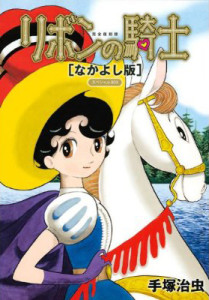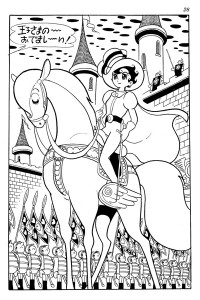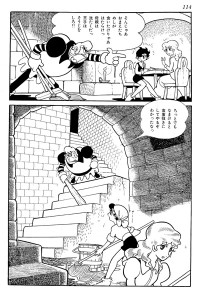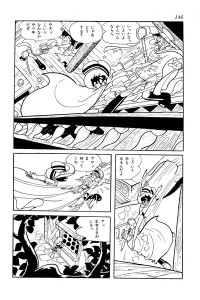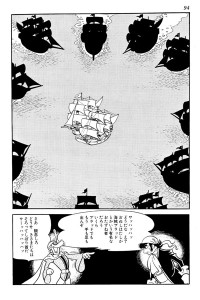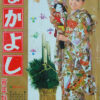Princess Knight [Nakayoshi] (Manga)
Also known as リボンの騎士 [なかよし] (Ribon no Kishi [Nakayoshi])
| English Title: | Princess Knight [Nakayoshi] |
| In English? | Yes |
| Japanese Title: | リボンの騎士 (なかよし) Ribon no Kishi (Nakayoshi) |
| Type: | Ongoing Serial |
| Original run: | 1963/01 – 1966/10 |
| Published in: | Good Friend なかよし |
| Published by: | Kodansha |
| Volumes: | 3 MT-004 | MT-005 |MT-006 |
Although it is a remake of the original story, Princess Knight [Nakayoshi] (1963-64) is the more well-known of the two. This completely re-drawn and re-written version of Princess Knight was serialized in Good Friend from January 1963 to October 1966 and was the main inspiration for the animated television show. It should not be confused with The Twin Knights (1958-59), which was a true sequel to the original story.
What it’s about
Set in a medieval fairy-tale type setting, this is the story of young Princess Sapphire. When Sapphire is in heaven waiting to be born, a mischievous cherub named Tink accidentally gives her a second heart, and the young girl is born with both the brave and adventurous blue heart of a boy and the loving and caring red heart of a girl. Realizing a mistake has been made, God sends Tink to earth with instructions to retrieve the blue boy’s heart. However, Princess Sapphire has been born into the Kingdom of Silverland, where only a male heir can inherit the throne, so retrieving the boy’s heart is no easy task. In order to keep the evil Duke Duralumin from becoming next-in-line to the throne, the king and queen announce that a prince has been born – forcing Sapphire into a life of deception.
For the first twelve years, things proceed relatively well, with Sapphire receiving training in the manly arts in public and the womanly arts in private. However, she is constantly on the lookout, side-stepping traps set by Duke Duralumin and his associate, Lord Nylon, in an attempt to confirm their suspicions that “he” is really a “she”. However, after one of Lord Nylon‘s traps goes sideways during the carnival, the king dies in an accident and young Prince Franz Charming, from the neighbouring Kingdom of Goldland is accused of murder and taken into custody.
This sets off a series of events that sees Sapphire “disguise” herself as a girl to break her new-found love out of jail, be briefly coronated as king, only to have her secret exposed and be banished from the kingdom – with Duralumin‘s dimwit son Plastic installed as King in her stead. Taking the identity of the Princess Knight, Sapphire fights to save her mother, her prince (who still thinks she’s a man), and her very own “girl’s heart” from the clutches of the evil with Madame Hell, who wants to make her tomboyish daughter Hecate more feminine by any means necessary. Along the way, she gets turned into a swan, sparks off a war between the sexes, and meets the handsome pirate, Captain Blood, that, unlike her Prince Charming, who still thinks Sapphire is a man and is only in love with her girly disguise, sees Sapphire for the beauty she truly is.
Oh, and just when it seems things are about to wrap up in a happy ending, Sapphire‘s beauty invokes the jealousy of the goddess Venus. This sets off another round of mayhem, with Sapphire suffering from amnesia, thinking she’s a man, and entering a sword fighting competition at the behest of her new “girlfriend”… all while poor Prince Charming chases around after her.
Will these two EVER get together?
What you should know
Osamu Tezuka was well-known for “tinkering” with his stories, never believing them to be completely finished, and taking every opportunity to “improve” them. So, the most important thing to know about Princess Knight [Nakayoshi] (1963-66) is that it is a remake.
However, despite following both the original manga series, Princess Knight [Shojo Club] (1953-56) as well as the sequel, The Twin Knights (1958-59), for many people it is considered the definitive version of the Princess Knight story. There are three main reasons why this version has become the one most closely associated with the name Princess Knight:
The first is the overall improvement in the quality of Tezuka’s artwork during the intervening decade. When Princess Knight [Shojo Club] (1953-56) began in the early 1950s, Tezuka’s artwork, though much more solid than it had been just a few years earlier, still showed the huge influence that the Disney style had had on it. However, by the mid-1960s, Tezuka’s artwork had a style all its own.
The second is the timing of the series. Princess Knight [Shojo Club] (1953-56) is often, and erroneously, cited as being the first manga series for young girls (shojo). Yet, in the mid-1950s it was certainly a lot less visible as a genre than it was by the mid-1960s, and with it came an increase in the size of the readership. It also certainly doesn’t hurt that Princess Knight [Nakayoshi] (1963-66) was on the shelf almost 10 months longer than its predecessor.
The third, in something that remains true to this day, is that Princess Knight [Nakayoshi] (1963-66) benefited greatly from having an animated television show associated with it. Despite the fact that the Princess Knight (1967-68) storyline differs significantly, both series share similar character designs, and were in the public eye at roughly the same time, with the television show starting barely a year after the conclusion of the manga series. This gave Tezuka’s readership a significant boost from the usually much higher number of television viewers.
It is also interesting to note there are some significant differences between the two manga series. Most notably absent from the Nakayoshi edition is the villainous Mephisto, with his role having been assumed by the evil Madame Hell. Presumably this was done to maintain the overall male/female balance, as Tezuka’s key addition to the remake is the handsome pirate, Captain Blood – an early instance (if not the first) of the “bad boy with the hidden heart of gold” style of character that has since become a manga staple. Blood‘s introduction significantly increases the tension in the plot, giving Tezuka someone to play off Franz Charming‘s wholesome goodness with Blood‘s rugged charm. The result is a much more complex and interwoven plot and a good example of Tezuka’s continuing growth as a storyteller. However, given Tezuka’s penchant for re-purposing story elements, the inclusion of Venus, the Goddess of Love, creates a noticeable break in the story’s flow. Instead of allowing the story to come to its natural conclusion, with the defeat of the two main antagonists, Duke Drualumin and Madame Hell, Tezuka makes an unexpected left turn, suddenly pitting his heroes against a new antagonist with no previous connection to the story. The end result is that the seams are clearly showing at the point where the story receives its tacked on extension, and it becomes a good example of Tezuka trying to do “too much” all at once.
So, as to whether or not the remake is, in fact, better than the original, it’s up to the reader to decide.
Finally, it is interesting to note there was also a little-known second Princess Knight remake based on a science-fiction story written by Osamu Tezuka, but with artwork done by Mushi Studio’s artist, Hideaki Kitano. Released concurrently with the Princess Knight animated television broadcast, simply put, it was a flop. Lasting only six weeks – from June 13 to July 18, 1967 – it was serialized in issues #24-29 of the magazine Shojo Friend. The basic premise to the story is that Franz, living in Paris in the year 2440 bets all his money on the fact that his ancestor Sapphire was a woman. To prove it (and win the bet), Franz uses a time machine to travel back to Silverland in the year 1581. Although the last issue (#29) was labeled “Part 1 – Complete”, a Part 2 was never written and the series was cancelled.
Where you can get it
Luckily for English-speaking fans, Princess Knight [Nakayoshi] (1963-66) has been translated into English twice. In 2001, Japanese publisher Kodansha released a bi-lingual Japanese/English edition, which is now long out of print and may be difficult to find even through an online retailer. This was followed in 2011 by a very nice 2-volume edition released by Vertical Inc.
What else you should check out
Check out the link below for chapter summaries and more detailed publication information on Princess Knight [Nakayoshi] (1963-64) serialization in Good Friend.

